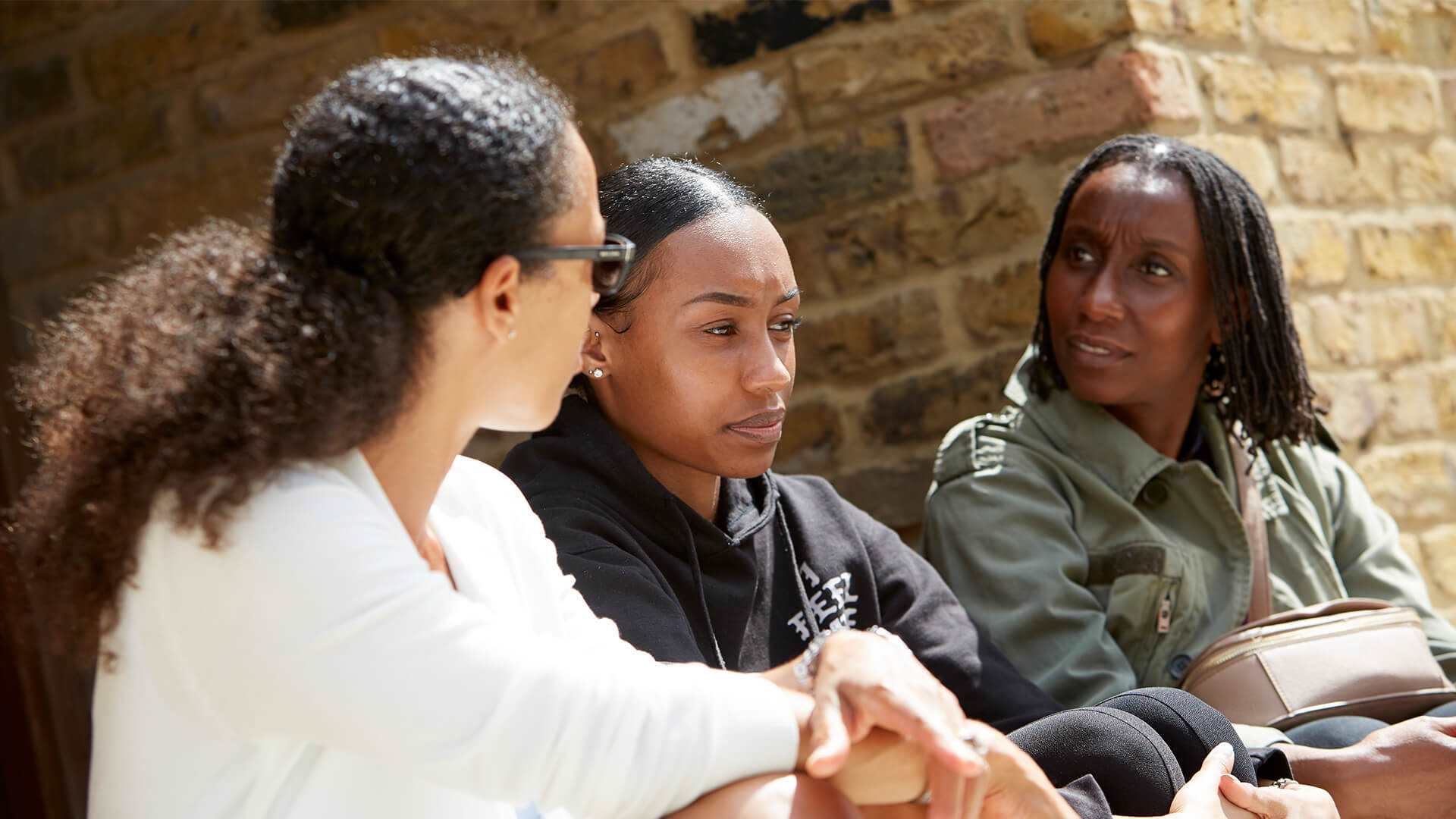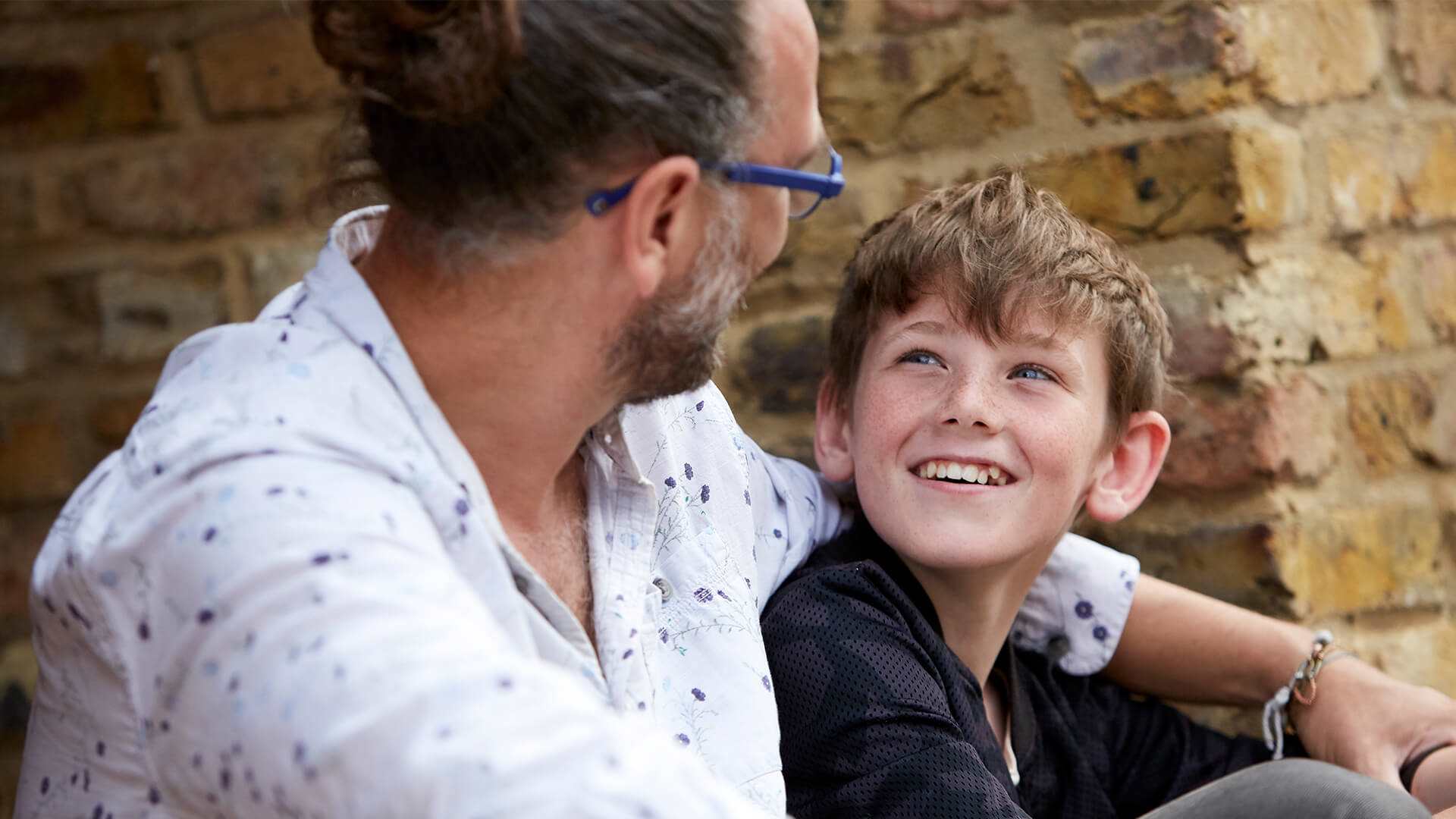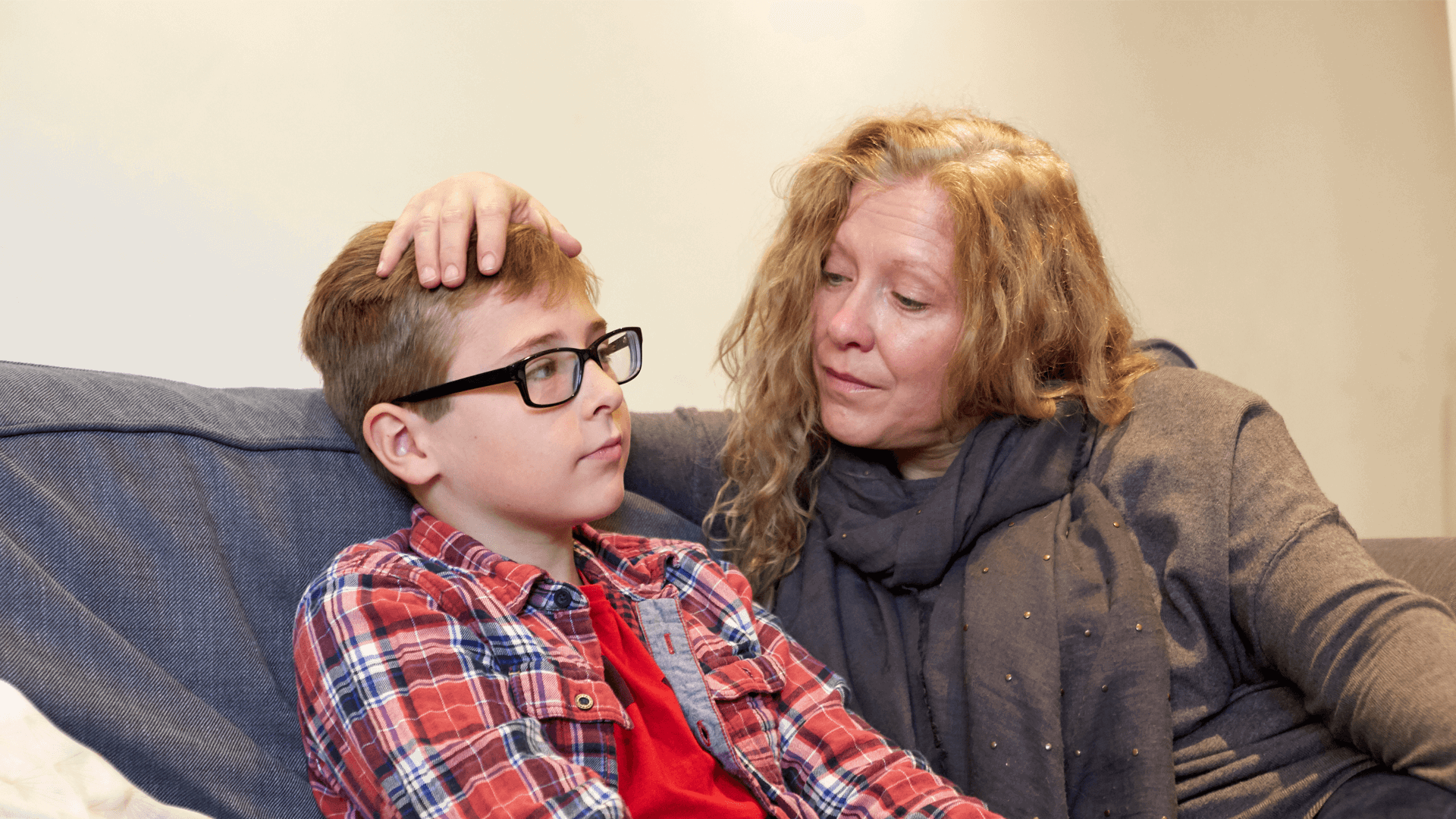Talking to your child

Talking to your child about how they’re feeling can be hard. You might feel like you don’t know where to start or when a ‘good time’ to talk is.
By taking 20 minutes to do an activity you both enjoy, you can create a relaxed space for getting the conversation started. Here, we’ve got lots of activity ideas, conversation starters and advice for making talking easier.
Activities you can do with your child
Quick activities when you have less time
Here are some short activities that you and your child can do together:
- Play a ball game. Football, catch, basketball, dodgeball … there are endless ball games to choose from. You can ask your child to pick a game they’d like to play or ask them about their favourite sports team.
- Ready, set… bake. Baking is a great way to have fun together and there are so many bakes to choose from including with fairy cakes, scones, traybakes or energy balls.
- Create something together. There are so many things you can make in 20 minutes. This can be as simple as doing a paint-by-numbers, jigsaw, designing your own Birthday or thank you cards, or trying something new like painting your own T-shirt designs.
- Draw cartoons of each other. Sometimes, all you need is pen and paper. Create cartoon drawings of one another, and other family members, cats, dogs, fish – have fun! You could also try drawing with your eyes closed or not taking your pen off the paper to add an extra challenge.
- Indoor picnic. 20 minutes isn’t quite enough time to head out to the beach with a picnic blanket, but it’s perfect for having one indoors. Lay out a blanket, pick out your family’s favourite finger food and have a picnic in the comfort of home.
- Tech-free games. Take a screen break with tech-free games like 20 questions, cat's cradle, marbles, jacks, the floor is lava, skipping and more. There are so many 20 minute games to choose from.
- Indoor treasure hunt. Hide some things (such as toys, messages or even sections of a story) around the house, create some clues and see if your children can guess where they are!
- Put on your dancing shoes. If your child loves to dance, let their feet do the talking. Ask them to pick out their favourite song and dance like you mean it!
- Sing it. From car singing to serenading the family in the kitchen, turn up your favourite ballads and sing along. You could turn it into a game by challenging them too sing in the style of their favourite film or TV character.
- Take a walk. Sometimes taking 20 minutes is as simple as taking a walk, whether it’s through nearby countryside, to the shops or around the block with the family dog.
- Go for a drive. Car journeys are a great opportunity for 20 minutes with your child. Encourage them to leave their phone for a while, turn down the radio and strike up a conversation.
- Ready, set… bake. Baking is a great way to have fun together and there are so many bakes to choose from including with fairy cakes, scones, traybakes or energy balls.
- Create something together. There are so many things you can make in 20 minutes. This can be as simple as doing a paint-by-numbers, jigsaw, designing your own Birthday or thank you cards, or trying something new like painting your own T-shirt designs
- Have a kickabout. Football, catch, basketball, dodgeball … there are endless ball games to choose from. You can ask your child to pick a game they’d like to play or ask them about their favourite sports team.
- Share your music. You can create playlists together for the different parts of your day – what do you both like to listen to when you wake up, wind down or cook dinner? You may surprise each other with your choices and even introduce each other to something new.
- Draw or colour-in together. If your child likes drawing, doing it together can be as easy as doodling on a piece of a paper. Or you could try an adult colouring book together.
- Yoga time. Designed around controlled movement and breathing techniques, yoga is an easy one to do together at home. New to yoga? A quick search on YouTube will bring up lots of beginners’ videos you can try.
For weekends, school holidays or an evening when you’ve got more time
Here are some longer activities that you and your child can do together:
- Build a fort. Use blankets, bedsheets, cushions, chairs and fairy lights to create your own cosy little fort. Be warned: it will take several attempts to keep it all up, but so worth it once you’re inside!
- Flex those green fingers. Sow some seeds and watch them grow together! Begin with seedlings on the windowsill and watch them grow before moving them into window pots or even the garden. If you’re not green fingered, begin with something easy like sunflowers or sweet peas.
- Have a games night. You could learn a new board or card game, choose a video game to play, or even try a family poker night.
- Start a new series. Getting into a gripping series is a great way to spend time together, and you can talk about all the twists and turns through the week!
- Share your favourite books. Have a go at reading each other’s favourite books, and then talk about them together. This is a great way to learn more about each other and discover common ground.
- Cook together. Ask your child if there’s something they want to learn how to cook, or a dish they’d like to teach you, and make it with them – then enjoy eating what you make together. If you want to heat up the competition, try a family ‘Come Dine With Me’ where each person takes a turn to cook and entertain the family for an evening, and is given a mark out of ten for their efforts.
- Coffee shop date. Sometimes it’s nice to sit back with a cup of something warm and catch up! Whether it’s before or between running errands or make a special trip, sitting down and having a drink together could be just want they need to get them talking.
- Have a games night. You could learn a new board or card game, choose a video game to play, or even try a family poker night.
Make an activity picker
Younger children might enjoy using an activity picker to decide on an activity together. You can download our template and follow the instructions below to make one with your child.
- Print out the activity picker on A4 and cut it out.
- Flip your activity picker over so the blank side is facing up.
- Fold diagonally in half (starting from the bottom left corner, fold your activity picker so the bottom left corner meets the top right corner). Your activity picker should make a triangle. Crease the edge well. Unfold this, and do the same thing but starting with the bottom right corner, fold the activity picker in half diagonally. You should now have a creased point in the middle.
- Stay on the blank side and fold each corner so the points meet in the middle. Your activity picker will now look like a smaller square.
- Flip the activity picker over so you are on the printed side. You will now do the same step on this side, folding each corner into the middle. Your activity picker will now look like an even smaller square.
- Now fold your activity picker in half, so your square is a small rectangle. Unfold and fold in half again on the other side.
- Slot your thumbs and first fingers under the flap. You’re now ready to use your activity picker!
Conversation starters

Talking to your child about how they’re feeling can be tough, especially if you’re concerned that they're having a hard time. You might not know what to say, or feel worried about how your child will react.
It doesn’t matter what topic the conversation starts with – it’s about the opportunity it gives you to talk about feelings and provide comfort.
Whilst the activity is underway, what's the best way to encourage your child to open up? Have a look at some of our conversation starters.
Want to have conversation starters on hand? You can also download the full list here.
Here are some things you could ask to get the conversation started:
- What was the best bit of your day?
- What was the worst bit of your day?
- What did you do today that made you proud?
- How are you feeling?
- What would you like to talk about?
If your child is having a hard time, you can try to find out how they’d like to be supported by asking gentle questions like:
- How can I support you through this?
- Do you want to talk about what’s going on?
- Is there anything you need from me? Space, time to talk, time to do something fun?
- What was the biggest problem you had today? What helped?
Is there anything you need from me? Space, time to talk, time to do something fun?
If they don’t want to talk right now

Reassure them that they can talk to you at any time. You could say things like:
- You can talk to me, I’m here for you.
- If you need to talk to someone else, that’s okay too.
- If you talk to me about what is worrying you, I can do my best to help.
- Even if I don’t understand, know that I want to.
- We’re going to get through this together.
You could also see whether other forms of communication like writing a letter or texting would make it easier for your child to let you know what’s going on.
Remember that you know your child. You can tell when it isn't the right time or they aren’t in the mood to talk.
If you need to talk to someone else, that’s okay too.
If your child tells you they’re struggling
If your child tells you they’re struggling, it’s important to make sure they feel seen and heard. If you’re worried about something that’s come up in conversation, be honest and clear about how you see things and how you want to support them.
When responding, it helps to:
- Validate their feelings. You could say ‘it’s really understandable that you’re feeling…’ to let them know that their feelings are okay.
- Thank them for sharing what’s going on and be encouraging about the way they’ve opened up.
- Let them know that you love them, you're there for them, they can talk to you whenever they need to, and you can help them get support if they need it.
- Ask them if there's anything you could do that they would find particularly helpful.
- Spend time together thinking about what’s making them feel this way. It could be something at home or school, a relationship with a friend or family member or something else.
- Let your child know about the helplines, textlines and online chat services that are available - which you can find at the end of this guide. Young people can find it difficult to talk and worry about upsetting their parents, so reassure them that it’s okay to open up to other people.
- Remind your child that this is temporary. Reassure them that things can change and they can feel better.
- Avoid conversations at the height of distress. It's important to be there for them, but it can be more helpful to talk about the causes when things are feeling calmer.
Tips for providing emotional support
Where to get help
Useful helplines and websites
-
The Mix
Offers support to anyone under 25 about anything that’s troubling them.
Email support available via their online contact form.
Free 1-2-1 webchat service available.
Free short-term counselling service available.
- Opening times:
- 3pm - 12am, seven days a week
-
Childline
If you’re under 19 you can confidentially call, chat online or email about any problem big or small.
Sign up for a free Childline locker (real name or email address not needed) to use their free 1-2-1 counsellor chat and email support service.
Can provide a BSL interpreter if you are deaf or hearing-impaired.
Hosts online message boards where you can share your experiences, have fun and get support from other young people in similar situations.
- Opening times:
- 24/7
-
Ollee
A virtual friend for 8-11 year olds and their parents that helps families think about feelings and talk about difficult topics. You can download the app here.
-
MeeToo
A free app for teenagers (11+) providing resources and a fully-moderated community where you can share your problems, get support and help other people too.
Can be downloaded from Google Play or App Store.